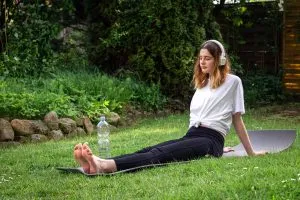When it comes to yoga, your mat is so much more than just a piece of equipment—it’s your personal island of zen!
Whether you’re a newbie or a seasoned yogi, picking the right mat thickness can make a world of difference for your joints.
So, look at the cushy, squishy world of yoga mats and discover how to keep your knees and elbows happy while you flow through your practice.
Ready to find the perfect mat for your joint health? Let’s get started! 🌟🧘♀️

How Yoga Mat Thickness Affects Joint Health
Yoga mats come in various thicknesses, and each has its own impact on your practice.
Thinner mats, typically around 1-2mm, offer better stability for balance poses but might leave you feeling every bump and groove of the floor.
On the other hand, thicker mats, ranging from 4mm to over 6mm, provide more cushioning, which can be a lifesaver for your knees and other sensitive joints.
Thick vs. Thin Yoga Mats for Knee Support
If you’ve ever winced in pain during a kneeling pose, you know how important cushioning can be.
Thicker mats, especially those over 6mm, offer excellent knee support and can help prevent discomfort during poses that put pressure on your joints.
However, they can also make balance poses a bit more challenging.
It’s all about finding the right balance (pun intended!).
Yoga is becoming highly recommended as a support for anyone with arthritis. Here’s a great article from John Hopkins Arthritis Centre about Yoga for Arthritis.

Cushioning in Yoga Mats for Pain Relief
For those with sensitive joints or existing injuries, the best yoga mat thickness for joint support is often on the thicker side.
Mats made from dense materials like natural rubber or TPE (thermoplastic elastomer) provide both cushioning and stability.
These materials are not only comfortable but also eco-friendly, which is a win-win!

Choosing the Right Yoga Mat for Sensitive Joints
When selecting a yoga mat, consider your personal needs and the type of yoga you practice.
If you travel frequently, a thinner, more portable mat might be ideal.
But if joint protection is your top priority, investing in a thicker mat with good density is the way to go.
Remember, the material of the mat is just as important as its thickness.
Natural rubber mats, for example, offer excellent support and are non-slip, making them perfect for both dynamic and gentle yoga practices.

Personal Tips from a Yoga Instructor
As a yoga instructor, I’ve seen firsthand how the right mat can transform a practice.
Here are a few tips to help you choose the perfect mat:
- Test Different Thicknesses: Don’t be afraid to try out different mats to see what feels best for you. What works for one person might not work for another.
- Consider Your Practice Style: If you practice a lot of balance poses, a medium-thickness mat (around 4-5mm) might be ideal. For more restorative or gentle yoga, a thicker mat can provide the cushioning you need.
- Think About Portability: If you often take your mat on the go, a travel mat might be more convenient, even if it means sacrificing some cushioning.
- Eco-Friendly Options: Look for mats made from natural materials like rubber, cotton, or jute. They’re better for the environment and often provide better support.
In conclusion, choosing the right yoga mat thickness is all about balancing comfort, support, and practicality.
By considering your personal needs and the type of yoga you practice, you can find a mat that enhances your practice and protects your joints.
Happy practicing!





